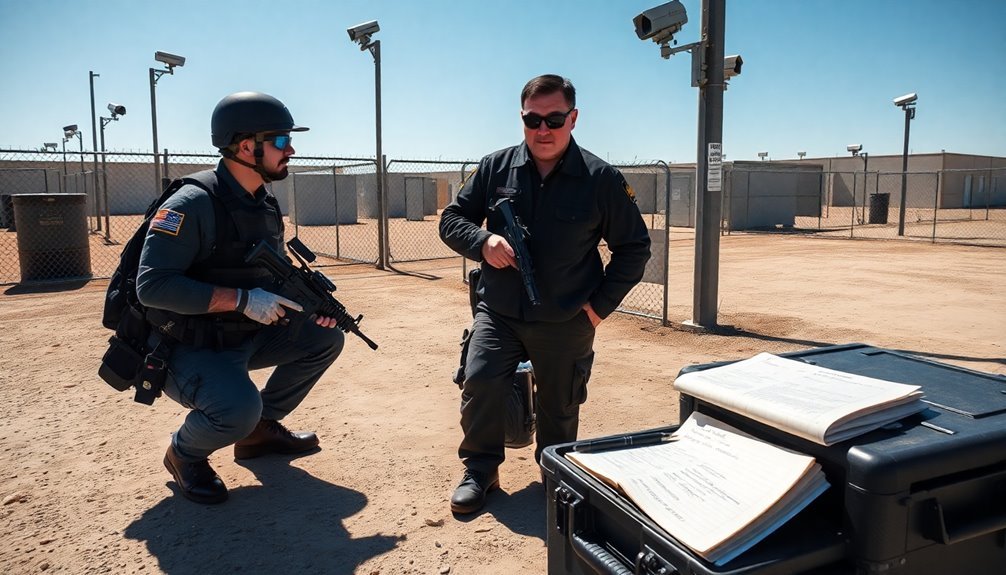To build your protection program certification, you'll need to meet the minimum age (18) and experience requirements first. Choose between traditional classroom or online training paths that fit your schedule and learning style. Gain hands-on field experience through specialized programs in areas like motorcade operations and protective doctrine. Complete required classroom training, maintain detailed documentation of your progress, and prepare thoroughly for final examinations. Don't forget to verify program accreditation status and keep your certifications current through ongoing professional development. The journey to becoming a certified protection professional unfolds with these essential steps.
Meet Age and Experience Requirements

Meeting age and experience requirements serves as the foundation for starting your protection program certification journey. You'll need to be at least 18 years old to obtain your Certified Protection Officer (CPO) certification or Personal Protection Specialist registration in Virginia.
While you can participate in CPO training before turning 18, you'll only receive a completion certificate until you reach the required age. Security professionals value the global credibility that comes with CPO certification.
To qualify for CPO certification, you'll need either 6 months of full-time protection officer experience or 1 year of part-time experience. If you're enrolled in recognized classroom training programs, this can count as equivalent experience toward your certification.
For Personal Protection Specialist registration in Virginia, you'll need to complete all initial training requirements successfully.
If you're interested in OSHA 10 training as part of your professional development, there's no specific age restriction or experience requirement. This training serves as foundational safety education and can complement your protection program certification.
You can access these training programs through various formats, including online platforms or traditional classroom settings, making it easier to fit the requirements into your schedule.
Choose Your Training Path
You'll find two main approaches to earning your protection certification: traditional classroom instruction or flexible online learning platforms.
Protection programs offer specialized tracks including Microsoft Information Protection, CPO certification, and OSHA safety training to match your career goals.
If you're looking to fast-track your certification, self-paced online options let you complete coursework according to your schedule while still accessing all necessary training materials and support. Joining professional networking communities helps you connect with experienced administrators and stay current with industry trends.
Traditional Vs Online Options
When choosing between traditional and online protection program training, it's vital to understand how each path aligns with your learning style and life circumstances. Traditional training offers structured learning environments with direct professor access and built-in networking opportunities, while online programs provide flexibility and cost-effective solutions for busy professionals.
| Traditional Training | Online Training |
|---|---|
| Fixed class schedules | Learn at your own pace |
| In-person networking | Virtual collaboration |
| Campus facilities access | Technology-based resources |
| Direct professor interaction | Digital communication |
| Higher overall costs | Cost-effective options |
You'll need to weigh the benefits against your personal situation. Traditional training delivers instant credibility and social interaction but requires significant time commitments and location dependency. Online programs offer immediate feedback and wider accessibility but demand strong self-discipline and reliable technical resources. Many online programs like National Paralegal College provide no-cost trial enrollment to help students make informed decisions about their educational path.
Consider your learning preferences carefully. If you thrive in structured environments with face-to-face interaction, traditional training might be your best choice. However, if you need flexibility and have strong time management skills, online training could provide the ideal path to certification while maintaining your current commitments.
Specialized Training Programs Available
Protection program certification offers several specialized training paths tailored to distinct career objectives and security focuses.
If you're pursuing protective service operations, you'll need to meet specific eligibility requirements, including current law enforcement status with arrest authority and valid weapons qualifications. This path equips you with extensive skills in motorcade operations, mission planning, and protective doctrine. Understanding human performance under stress is crucial for making effective decisions during high-pressure situations.
For those focusing on information protection, Microsoft's training program lets you choose between self-paced and instructor-led options. You'll learn to implement technical controls that align with organizational security requirements, culminating in Microsoft certification.
Critical Incident Stress Management certification through ICISF provides specialized training in crisis intervention. You can earn up to seven specific certificates, building expertise in various aspects of crisis management.
If you're interested in safety professional certifications, you'll find multiple paths including Certified Safety Professional and Graduate Safety Practitioner options. These programs require specific education and work experience prerequisites while developing your expertise in safety management, occupational health, and construction safety technology.
The Board of Certified Safety Professionals oversees these certifications, ensuring high professional standards in the field.
Fast-Track Certification Methods
Fast-track certification paths offer streamlined routes to professional credentials while maintaining rigorous standards. You'll find various options that can accelerate your journey toward becoming a certified protection professional, from self-paced programs to instructor-led training.
When selecting your fast-track path, it's vital to align the certification with your career goals and organizational requirements while considering the associated costs and benefits. Working with a third-party assessment organization can help ensure your documentation and processes meet all necessary standards.
To make the most of fast-track certification methods, consider these essential steps:
- Evaluate your training delivery preferences – choose between self-paced learning, instructor-led courses, online guided training, or traditional classroom settings based on your learning style.
- Review certification costs and available bundles – compare options like the StateRAMP Fast Track process or EC-Council's exam prep packages to maximize value.
- Match certifications to your expertise level – select programs that align with your current skills and desired career progression, such as CISSP for exhaustive security knowledge.
- Consider industry-specific requirements – focus on certifications relevant to your sector, whether it's cloud security, ethical hacking, or organizational information protection.
Choose a path that balances speed with thorough preparation to guarantee you're well-equipped for certification success.
Gain Practical Field Experience

Through thorough training programs and real-world practice, you'll develop the essential skills needed for professional protection services. Focus on extensive programs like the Protective Services Professional Certificate Program, which offers hands-on experience in protective driving and agent development. The program's comprehensive 7-day combined program ensures mastery of both vehicle operations and agent protection skills.
Advance your expertise by pursuing specialized training certifications, such as the Certified Protection Professional (CPP) program. You'll gain vital knowledge in threat assessment, surveillance detection, and use of force – skills that are essential for high-level protection work.
| Training Component | Key Benefits |
|---|---|
| Field Exercises | Real-world scenario experience |
| Simulation Drills | Enhanced decision-making skills |
| Advanced Courses | Specialized technical knowledge |
Don't overlook the importance of industry networking and professional affiliations. Join organizations like ASIS International to access valuable resources and connect with experienced professionals. These connections often lead to mentorship opportunities and practical field experience. Remember to maintain regular practice through drills and exercises to stay proficient in your protective service skills. Your practical experience will grow through continuous engagement in training programs, field exercises, and professional development opportunities.
Select Appropriate Certification Program
When choosing your protection certification pathway, it's essential to evaluate programs that align with your career goals and meet industry requirements. The CPO program through IFPO offers a solid foundation, requiring 6 months of full-time or 1 year of part-time experience. You'll need to be 18 for full certification, though you can start training earlier and receive a completion certificate. Many professionals pursue VA DCJS credentials since Virginia has specific requirements for close protection services.
Consider these key certification options based on your specialized focus:
- CPO Certification: Choose this for thorough asset protection training, available in both online and traditional textbook formats.
- Executive Protection Programs: Opt for these specialized credentials if you're pursuing close protection or bodyguard roles.
- Safety Professional Certifications: Consider ASP or CSP if you're targeting safety director positions.
- Specialized Safety Credentials: Look into CHMM certification for hazardous materials management roles.
Select a program format that fits your schedule and learning style. Online training offers flexibility with e-books and digital exams, while traditional classroom settings provide hands-on experience.
Remember that some states require specific certifications for certain protection roles, so verify your local requirements before making a final decision.
Complete Required Classroom Training

You'll need to select training programs that carry proper accreditation and align with ISC guidelines to meet the strict hour requirements for Level III and IV certifications.
Organize your required coursework in a vertical list format to track completion status efficiently and maintain clear documentation of your progress.
It's crucial to block out dedicated study time for both theoretical components, like physical security systems and threat analysis, and practical exercises that include protective driving and surveillance detection.
Make sure you're keeping detailed records of your attendance and completed hours, especially for continuing education requirements that must be fulfilled through department-approved schools.
Choose Accredited Training Programs
In accordance with industry standards, selecting an accredited training program serves as your foundation for a successful protection career. When you enroll in an accredited program, you'll benefit from verified quality standards, industry recognition, and structured curricula taught by experienced instructors.
Programs like the 39-Day Certified Executive Security Specialist (CESS) Course demonstrate the extensive training needed to excel in the protection industry.
To guarantee you're making the right choice, consider these essential factors when selecting your training program:
- Verify the program's accreditation status and industry affiliations to guarantee your certification will be widely recognized by potential employers.
- Look for blended learning approaches that combine classroom instruction with practical field training, including protective driving and venue security operations.
- Check that the curriculum covers vital elements like threat analysis, surveillance detection, and legal considerations.
- Confirm the program offers professional advancement opportunities through continuing education units (CEUs) and recertification options.
Remember that accredited programs are designed to comply with regulatory requirements while providing you with the hands-on experience necessary for real-world protection scenarios. Your choice of training program will directly impact your career trajectory and professional credibility.
Schedule Regular Study Sessions
After selecting your accredited training program, organizing a structured study schedule becomes your next priority. You'll need to establish specific time blocks for each protective services topic, from protective driving operations to protection agent development.
Break down your study sessions into manageable segments, focusing on one topic at a time to maintain clarity and depth of understanding.
Create a detailed weekly schedule that incorporates both classroom instruction and practical exercises. You'll want to dedicate time for interactive training sessions, field exercises, and engagement with subject-matter experts.
Make sure to include regular breaks to prevent burnout and maintain peak focus during your studies.
Leverage all available training resources, including study guides, online materials, and hands-on training opportunities. You'll benefit from participating in group training sessions where you can learn from both instructors and peers.
Don't forget to schedule regular progress assessments to identify areas that need additional attention. Keep your schedule flexible enough to adjust based on your performance and understanding of different topics.
Remember to prioritize complex subjects during your peak concentration hours for maximum retention and comprehension.
Track Attendance Requirements
Keeping track of your attendance throughout the protection program certification process stands as a fundamental responsibility. You'll need to maintain accurate records of your participation in mandatory classes and make certain you're meeting all timeframe requirements for completion.
Many certification programs have strict attendance policies that must be followed, including specific hours of training within designated periods.
You should document your attendance using both automated systems when available and manual sign-in sheets as backup. Keep copies of all verification documents, including your ID checks and session completion certificates. This documentation becomes imperative for regulatory compliance and future audits of your certification status.
- Monitor your progress toward completing required hours, such as the 8 Hour Pre-Assignment Training and 16 Hour On-The-Job Training within specified timeframes.
- Store digital and physical copies of attendance records, completion certificates, and verification documents.
- Track renewal deadlines for certifications, particularly for programs requiring periodic recertification.
- Create a personal attendance log that aligns with regulatory requirements and can be easily referenced during audits.
Remember to verify each course's specific attendance requirements, as they may vary by jurisdiction or certification type. Stay proactive in maintaining your records to avoid certification delays or compliance issues.
Master Online Learning Modules
Mastering online learning modules requires a strategic approach that combines dynamic content with practical applications. You'll need to engage with interactive content, including video walk-throughs and simulations that demonstrate real-world protective scenarios. These dynamic elements help bridge the gap between theory and practice.
Access your course materials across multiple devices to maximize your learning flexibility. Whether you're using a desktop at home or a mobile phone during breaks, you'll want 24/7 availability to study materials.
Take advantage of live support options when you need clarification on complex topics or want to discuss specific scenarios with experienced instructors.
Focus on completing each structured module systematically, including all homework assignments and tests. You'll benefit from the combination of theoretical knowledge and practical applications through case studies and simulations.
Don't skip the international considerations and cultural awareness components, as they're essential for global certification recognition.
Track your progress through regular assessments and make use of feedback from professional instructors. If you're part of a team, consider group enrollment to access training discounts while maintaining individual progress tracking.
Prepare For Final Examination

Successful completion of your online modules sets the stage for the final examination phase of your protection program certification. You'll need to develop a thorough strategy that maximizes your preparation time and confirms you're fully ready for the test.
Start by reviewing the exam blueprint to understand the structure and weight of different topics, then create a personalized study plan based on your strengths and weaknesses.
To effectively prepare for your final examination:
- Map out your study schedule using the exam blueprint, allocating more time to heavily weighted topics and areas where you need improvement.
- Utilize assessment tools and practice exams to identify knowledge gaps and track your progress.
- Form study groups and use flash cards to reinforce key concepts, definitions, and critical safety regulations.
- Access official training resources, including webinars, resource centers, and practice exams from authorized sources.
Don't forget to engage in interactive learning processes throughout your preparation. Schedule regular study sessions that fit your daily routine, and make use of training consultants when you need additional guidance.
Complete assessment exams after each study course, and conduct a thorough final review before taking the certification examination.
Document Previous Security Experience
Accurate documentation of your security experience forms a critical foundation for your Protection Program Certification. You'll need to demonstrate either six months of full-time protection officer experience or one year of part-time work to qualify for the CPO program. Make sure you're maintaining detailed records of your job duties, responsibilities, and training credentials.
| Experience Type | Duration Required | Additional Notes |
|---|---|---|
| Full-Time Officer | 6 months | Primary qualification |
| Part-Time Officer | 1 year | Equivalent experience accepted |
| Student Training | Program completion | Certificate until age 18 |
| Security-Related Work | Varies | Must be relevant to field |
If you're currently a student under 18, you can still participate in the program, but you'll receive a certificate of completion until you reach the required age. Your documentation should clearly outline your specific roles in security-related work, whether through private security companies or recognized training programs. State-specific requirements, like those in Texas or Virginia, may require additional documentation. Remember that certification bodies like IFPO will scrutinize your experience records, so maintain accurate documentation to enhance your professional credibility.
Submit Professional Credentials

Before sending in your application, you'll need to verify that your experience meets the specific certification requirements outlined by bodies like NCCA and DoD.
You should promptly submit all your supporting documentation, including your SFPC, APC, or other relevant security certifications that demonstrate your qualifications.
Organize your certificates in chronological order to clearly show your professional progression and make it easier for the accrediting body to review your credentials.
Verify Experience Requirements First
Professional credentialing begins up front with a thorough review of your experience requirements. Each certification program demands specific levels of experience, and you'll need to verify that you meet these criteria before investing time and resources into the application process.
For example, if you're pursuing a CSP certification, you'll need a bachelor's degree plus four years of safety experience with at least half your time dedicated to safety duties.
Don't assume you can't qualify if you lack full-time experience. Many certifications offer flexibility in how they assess your background. Part-time work often counts toward full-time equivalency, and some programs accept relevant training or education as substitutes for experience.
- Review the specific time requirements for your desired certification (e.g., CCSP requires 5 years in IT with 3 years in security)
- Document your experience carefully, including both full-time and part-time positions
- Check if your current educational programs or training courses count toward eligibility
- Verify that your experience aligns with the certification's required domains or focus areas
Consider starting with entry-level certifications like CPO if you're new to the field, as these typically require less experience and can serve as stepping stones to advanced credentials.
Submit Supporting Documentation Promptly
The certification process takes off when you gather and submit your supporting documentation. You'll need to verify that all documents contain key identifying information, including your date of birth, last four digits of your Social Security Number, and your current name exactly as listed on your account.
Prepare your documentation package with original official transcripts from all college studies, relevant exam score reports, and proof of teaching or professional experience. If you hold certificates from other states, include copies of these as well.
Remember to keep everything organized and clearly labeled.
When submitting your documents, use secure methods for uploading and avoid password-protected files unless you're providing the necessary passwords. Submit all materials to the specified address, such as the New York State Education Department. Don't forget to maintain records of everything you've submitted for future reference.
For certification maintenance, you'll need to track your professional development units (PDUs) and submit documentation for any waiver requests. Keep in mind that waiver periods won't exceed 180 days, and you must satisfy specific professional development categories outlined in the guidelines.
Make sure all documents are complete, legible, and relevant to your certification requirements.
Organize Certificates Chronologically
Once you've gathered your documentation, organizing your certificates chronologically creates a clear path for reviewers to follow your professional development.
A well-organized chronological system helps you track your progress, maintain accurate records, and demonstrate your growing expertise in the protection field. You'll want to implement a standardized format that clearly displays completion dates, issuing organizations, and certification numbers while highlighting your specializations and acquired skills.
- Create a centralized database or digital folder system that categorizes your certifications by date, with the most recent credentials at the top and earlier achievements following in descending order.
- Document each certification's key details, including training hours completed, examination dates, and any continuing education requirements needed for maintaining your credentials.
- Include unique certification numbers and issuing body information for easy verification, confirming you've eliminated any duplicate entries and maintained data accuracy.
- Update your chronological record regularly, adding new certifications as you earn them and noting upcoming renewal dates to keep your credentials current.
This organized approach confirms you'll have quick access to your certification history while presenting a professional and thorough overview of your qualifications.
Maintain Certification Standards
Maintaining your protection certification requires consistent dedication to professional development and careful attention to renewal requirements. You'll need to earn 100 PDUs within each two-year maintenance cycle, with at least 50% focused on security-related activities.
Don't forget to complete the mandatory ethics requirement course as part of your renewal process.
Track your PDUs through the online certification portal, where you can document both security and non-security professional development activities. Start preparing your renewal application 90 days before your certification expires, and verify you've updated your work experience information. Remember that you can only submit your recertification plan 30 days prior to expiration.
Be prepared for potential audits, as 10-30% of all certification records undergo review. Keep detailed documentation of your PDUs and professional development activities to guarantee compliance. If your records are selected for audit, they'll be checked against certification maintenance procedures. Non-compliant submissions will require revision and resubmission.
Use the available resources, including user guides and reference tables, to stay organized. Regular monitoring of your certification status will help prevent any lapses in your credentials.
Frequently Asked Questions
Can I Transfer My Certification Between Different Security Organizations or Countries?
Yes, you can transfer your certification between organizations if they meet eligibility requirements and follow proper transfer protocols. The process requires cooperation between both certification bodies and review of your certification status.
What Happens if I Fail the Certification Exam Multiple Times?
If you fail multiple times, you'll face financial losses, career delays, and confidence impacts. However, you can analyze gaps, create targeted study plans, and seek support to improve your chances of passing next time.
Are There Payment Plans Available for Certification Program Fees?
Yes, you'll find many institutions offer payment plans with installment options. You can split your certification costs into manageable payments, often without interest. Contact your chosen program's coordinator to explore available payment arrangements.
How Do I Replace a Lost or Damaged Certification Card?
You'll need to contact your certification's issuing organization with your name and certification date. They'll guide you through their replacement process, which may require documentation and fees for a new card.
Can Military Security Experience Count Toward Certification Requirements?
Yes, your military security experience can typically count toward certification requirements. You'll need to document your duties, training, and service time to demonstrate how they align with the certification program's standards.
In Summary
You've now got the key steps to build your protection program certification successfully. Don't forget to regularly review and update your credentials, network with other security professionals, and stay current with industry trends. If you'll follow these guidelines systematically, you're well on your way to becoming a certified protection specialist. Remember, your certification journey doesn't end with the exam – it's an ongoing commitment to excellence.





Leave a Reply